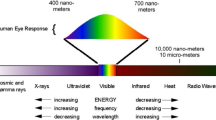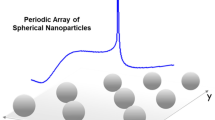Abstract
We present three important extensions of the plasmon hybridization (PH) method: a generalization of the method to include realistic non-Drude dielectric permittivities for metals, the development of an algorithm for the calculation of plasmon-induced electric field enhancements, and the extension of the PH method to the modeling of plasmonic Fano resonances. We illustrate these developments with an application to a silver nanosphere dimer and a symmetric silver nanosphere heptamer.
Similar content being viewed by others
References
Petschulat J, Cialla D, Janunts N, et al. Doubly resonant optical nanoantenna arrays for polarization resolved measurement of surface-enhanced Raman scattering. Opt Express, 2010, 18: 4184–4197
Chen C, Hutchison J A, Dorpe P V, et al. Focusing plasmons in nanoslits for surface-enhanced Raman scattering. Small, 2009, 5: 2876–2882
Liang H Y, Li Z P, Wang W Z, et al. Highly surface-roughened flower-like silver nanoparticles for extremely sensitive substrates of surface-enhanced Raman scattering. Adv Mater, 2009, 21: 4614–4618
Mu C, Zhang J P, Xu D S. Au nanoparticle arrays with tunable particle gaps by template-assisted electroless deposition for high performance surface-enhanced Raman scattering. Nanotechnology, 2009, 21: 015604
Ochsenkuhn M A, Jess P R T, Stoquert H, et al. Nanoshells for surface-enhanced Raman spectroscopy in eukaryotic cells: Cellular response and sensor development. ACS Nano, 2009, 3: 3613–3621
Wang W, Li Z P, Gu B, et al. Ag@SiO2 core-shell nanoparticles for probing spatial distribution of electromagnetic field enhancement via surface-enhanced Raman scattering. ACS Nano, 2009, 3: 3493–3496
Camargo P H C, Cobley C M, Rycenga M, et al. Measuring the surface-enhanced Raman scattering enhancement factor of hot spots formed between an individual Ag nanowire and a single Ag nanocube. Nanotechnology, 2009, 20: 434020
Kang T, Yoon I, Jeon K S, et al. Creating well-defined hot spots for surface-enhanced Raman scattering by single-crystalline noble metal nanowire pairs. J Phys Chem C, 2009, 113: 7492–7496
Zhai Y M, Zhai J F, Wang Y, et al. Fabrication of iron oxide core/gold shell submicrometer spheres with nanoscale surface roughness for efficient surface-enhanced Raman scattering. J Phys Chem C, 2009, 113: 7009–7014
Yang L, Wang H, Yan B, et al. Calibration of silver plasmon rulers in the 1–25 nm separation range: Experimental indications of distinct plasmon coupling regimes. J Phys Chem C, 2010, 114: 4901–4908
Encina E R, Coronado E A. Plasmon coupling in silver nanosphere pairs. J Phys Chem C, 2010, 114: 3918–3923
Ye J, Dorpe P V, Lagae L, et al. Observation of plasmonic dipolar anti bonding mode in silver nanoring structures. Nanotechnology, 2009, 20: 465203
Tzekezis C, Papanikolau N, Almpanis E, et al. Tailoring plasmons with metallic nanorod arrays. Phys Rev B, 2009, 80: 125124
Zhu J. Composition-dependent plasmon shift in Au-Ag alloy nanotubes: Effect of local field distribution. J Phys Chem C, 2009, 113: 3164–3167
Netzer N L, Gunawidjaja R, Hiemstra M, et al. Formation and optical properties of compression-induced nanoscale buckles on silver nanowires. ACS Nano, 2009, 3: 1795–1802
Li H J, Fu S L, Xie S X, et al. Induced electric fields and plasmonic interactions between a metallic nanotube and a thin metallic film. Science China: Phys Mech Astron, 2010, 53: 38–43
Li Z, Gong Q H. The plasmonic coupling of metal nanoparticles and its implication for scanning near-field optical microscope characterization. Chinese Sci Bull, 2009, 54: 3843
Pernice W H P. Finite-difference time-domain methods and materials models for the simulation of metallic and plasmonic structures. J Comp Theor Nanosci, 2010, 7: 1–14
Chremmos I. Magnetic field integral equation analysis of interaction between a surface plasmon polariton and a circular dielectric cavity embedded in the metal. J Opt Soc Am A, 2009, 26: 2623–2633
Khoury C G, Norton S J, Dihn T V. Plasmonics of 3D nanoshell dimers using multipole expansion and finite element method. ACS Nano, 2009, 3: 2776–2788
Teperik T V, Borisov A G. Optical resonances in the scattering of light from a nanostructured metal surface: A three-dimensional study. Phys Rev B, 2009, 79: 245409
Chau Y F, Chen M W, Tsai D P. Three-dimensional analysis of surface plasmon resonance modes on a gold nanorod. Appl Optics, 2009, 48: 617–622
Montgomery J M, Lee T W, Gray S K. Theory and modeling of light interactions with metallic nanostructures. J Phys: Condens Matter, 2008, 20: 323201
Mohammadi A, Jalali T, Agio M. Dispersive contour-path algorithm for the two-dimenional finite-difference time-domain method. Opt Express, 2008, 16: 7397–7406
Prodan E, Radloff C, Halas N J, et al. A hybridization model for the plasmon response of complex nanoparticles. Science, 2003, 302: 419–422
Liu H, Liu Y M, Li T, et al., Coupled magnetic plasmons in metamaterials. Phys Status Solidi B, 2009, 246: 1397–1406
Liu N, Liu H, Giessen H. Stereometamaterials. Nat Photonics, 2009, 3: 157–162
Kim S J, Jang D J. Hybridized surface-plasmon resonances of platinum colloid-adsorbed gold nanospheres. Mater Lett, 2008, 62: 4500–4502
Moradi A. Plasmon hybridization in metallic nanotubes with a nonconcentric core. Opt Commun, 2009, 282: 3368–3370
Yuan Z, Gao S W. Linear response study of plasmon excitation in metallic thin films: Layer dependent hybridization and dispersion. Phys Rev B, 2006, 73: 155411
Yang Z J, Zhang Z S, Zhang W, et al. Twinned Fano resonances induced by hybridized plasmons in Au-Ag nanorod heterodimers. Appl Phys Lett, 2010, 96: 131113
Yang S C, Kobori H, He C L, et al. Plasmon hybridization in individual gold nanocrystal dimers: Direct observation of bright and dark modes. Nano Lett, 2010, 10: 632–637
Funston A M, Novo C, Davis T J, et al. Plasmon coupling of gold nanorods at short distances and in different geometries. Nano Lett, 2009, 9: 1651–1658
Hu Y, Noelck S J, Drezek R A. Symmetry breaking on gold-silica-gold multilayer nanoshells. ACS Nano, 2010, 4: 1521–1528
Wu D J, Liu X J. Tunable near-infrared optical properties of three-layered gold-silica-gold nanoparticles. Appl Phys B, 2009, 97: 193–197
Ye J, Lagae L, Maes G, et al. Symmetry breaking induced optical properties of gold open shell nanostructures. Opt Express, 2009, 17: 23765–23771
Tabor C, Haute D V, El-Sayed M A. Effect of orientation on plasmonic coupling between gold nanorods. ACS Nano, 2009, 3: 3670–3678
Prodan E, Nordlander P. Plasmon hybridization in spherical nanoparticles. J Chem Phys, 2004, 120: 5444–5454
Wu Y P, Nordlander P. Plasmon hybridization in nanoshells with a nonconcentric core. J. Chem. Phys, 2006, 125: 124708
Brandl D W, Nordlander P. Plasmon modes of curvilinear metallic core/shell particles. J Chem Phys, 2007, 126: 144708
Wang H, Brandl D W, Le F, et al. Nanorice: A hybrid plasmonic nanostructure. Nano Lett, 2006, 6: 827–832
Dutta C M, Ali T A, Brandl D W, et al. Plasmonic properties of a metallic torus. J Chem Phys, 2008, 129: 084706
Nordlander P, Oubre C, Prodan E, et al. Plasmon hybridization in nanoparticle dimers. Nano Lett, 2004, 4: 899–903
Brandl D W, Oubre C, Nordlander P. Plasmon hybridization in nanoshell dimers. J Chem Phys, 2005, 123: 024701
Willingham B, Brandl D W, Nordlander P. Plasmon hybridization in nanorod dimers. Appl Phys B, 2008, 93: 209–216
Brandl D W, Mirin N A, Nordlander P. Plasmon modes of nanosphere trimers and quadrumers. J Phys Chem B, 2006, 110: 12302–12310
Urzhumov Y A, Shvets G, Fan J, et al. Plasmonic nanoclusters: A path towards negative-index metafluids. Opt Express, 2007, 15: 14129–14145
Mirin N A, Bao K, Nordlander P. Fano resonances in plasmonic nanoparticle aggregates. J Phys Chem A, 2009, 113: 4028–4034
Hao F, Nordlander P. Plasmonic coupling between a metallic nanosphere and a thin metallic wire. Appl Phys Lett, 2006, 89: 103101
Nordlander P, Prodan E. Plasmon hybridization in nanoparticles near metallic surfaces. Nano Lett, 2004, 4: 2209–2213
Le F, Lwin N Z, Steele J M, et al. Plasmons in the metallic nanoparticle-film system as a tunable impurity problem. Nano Lett, 2005, 5: 2009–2013
Le F, Zwin N Z, Halas N J, et al. Plasmonic interaction between a metallic nanoshell and a thin metallic film. Phys Rev B, 2007, 76: 165410
Park T H, Mirin N, Lassiter J B, et al. Optical properties of a nanosized hole in a thin metallic film. ACS Nano, 2008, 2: 25–32
Johnson P B, Christy R W. Optical constants of the noble metals. Phys Rev B, 1972, 6: 4370–4379
Fan J A, Wu C H, Bao K, et al. Self-assembled plasmonic nanoparticle clusters. Science, 2010, 328: 1135–1138
Mukherjee S, Sobhani H, Lassiter J B, et al. Fanoshells: Nanoparticles with built-in Fano resonances. Nano Lett, 2010, doi: 10.1021/nl1016392
Liu N A, Weiss T, Mesch M, et al. Planar metamaterial analogue of electromagnetically induced transparency for plasmonic sensing. Nano Lett, 2010, 10: 1103–1107
Alzar C L G, Martinez M A G, Nussenzveig P. Classical analog of electromagnetically induced transparency. Am J Phys, 2002, 70: 37–41
Le F, Brandl D W, Urzhumov Y A, et al. Metallic nanoparticle arrays: A common substrate for both SERS and SEIRA. ACS Nano, 2008, 2: 707–718
Author information
Authors and Affiliations
Corresponding author
About this article
Cite this article
Bao, K., Sobhani, H. & Nordlander, P. Plasmon hybridization for real metals. Chin. Sci. Bull. 55, 2629–2634 (2010). https://doi.org/10.1007/s11434-010-4070-y
Received:
Accepted:
Published:
Issue Date:
DOI: https://doi.org/10.1007/s11434-010-4070-y




